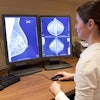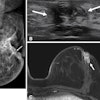The debate about the efficacy of mammography computer-aided detection (CAD) took another turn last week, when the Journal of the National Cancer Institute on July 27 released a study that found the technology doesn't improve the accuracy of mammography and increases a woman's risk of being called back unnecessarily.
Lead author Dr. Joshua Fenton, from the University of California, Davis, and colleagues found that the use of mammography CAD was associated with statistically significant lower specificity and positive predictive values, and the sensitivity of mammography screening for invasive breast cancer was similar regardless of whether or not CAD was used.
Reactions to the study have been mixed, with some experts critical of Fenton's research and others praising it. Some think the study's reliance on data that are more than 5 years old is problematic, while others believe the research indicates that the way that radiologists use CAD may be almost as important as the technology itself.
CAD isn't perfect
Dr. Michael Linver of X-Ray Associates of New Mexico conceded that CAD technology is imperfect. But he believes that it does help find additional cancers.
"[Fenton's latest research] does reflect the state of the art for the time period studied, but the biggest problem is that he's looking at old data, from 1998 to 2006," Linver said. "There's a huge difference in the state of technology now as compared to that time frame. Given the quality of CAD today, it's hard to believe that for the average radiologist there isn't a benefit."
Results similar to Fenton's have been published before, according to Dr. Wendie Berg, PhD, of the University of Pittsburgh, including a 2004 study conducted by Dr. David Gur, also of the University of Pittsburgh, that showed the use of breast CAD was not associated with statistically significant changes in recall and breast cancer detection rates.
Fenton's study indicates that radiologists need to step up, Berg told AuntMinnie.com.
"Radiologists need to take this [study] as a warning bell," she said. "We may be getting complacent as CAD has gotten better. Perhaps we've stopped following subtle masses or asymmetries as we should, since we know that breast CAD isn't as effective in marking these things as it is with calcifications."
Déjà vu all over again
Fenton is no stranger to breast CAD criticism. In 2007, he published a controversial study in the New England Journal of Medicine that suggests CAD actually reduced accuracy at the breast screening centers that used it -- and that the technology increased the biopsy rate by 19.7%.
The study prompted an outcry from CAD advocates, who pointed out that it included results from 43 facilities in three states, but CAD was used in only seven centers. In addition, the study included 429,345 single-read mammograms, but only 7% of these were read using CAD, and different radiologists read mammograms with CAD and mammograms without the technology.
A year later, Dr. Matthew Gromet, section chief of breast imaging at Charlotte Radiology, published a rebuttal to Fenton's work in the American Journal of Roentgenology, finding that CAD improved the sensitivity of mammography screening with only a small boost in the patient recall rate. Gromet's study consisted of a review of 231,221 screening mammograms.
Just a tool?
Double reading with two radiologists has always been the best tool to ensure a cancer is not missed or that benign findings are not unnecessarily biopsied, according to Bonnie Rush, president of Breast Imaging Specialists in San Diego. But most practices don't have the money to pay for an additional radiologist to perform second reads. That's where CAD comes in.
"CAD software used now is more sophisticated and displays less false-positive marks," Rush told AuntMinnie.com. "Additionally, [the new Fenton study was based on] film-screen-based CAD usage, which, as the study indicated, may have not produced the quality of CAD images we have now. It would have been interesting if [Fenton] had noted which CAD systems were used and to then determine if the type of CAD system used contributed to a higher than usual false-positive rate."
Ultimately, CAD is just a tool: It has value, but its value must be monitored, Rush said. No amount of improved algorithms can get around that.
"The improper use of CAD by radiologists -- reviewing CAD marks first and then the images, rather than the images first and then the CAD marks -- to justify a finding may continue to contribute to excessive biopsies, even with more sophisticated algorithms," she said.




















